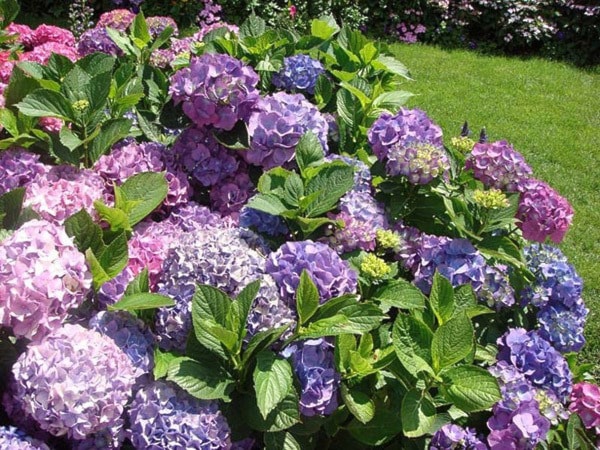Virtually every well-tended garden is now going through its summer cycle of colour, but one flowering shrub is preparing to steal the show. Hydrangeas, next to roses, are perhaps the most common deciduous flowering shrub in West Coast gardens. The ‘macrophylla’ or ‘garden hydrangea’ was introduced to England in 1736, and since then, a whole series of beautiful plants have been developed for the home garden.
When folks ask me to recommend a good vine for a shady north wall, my first choice is the climbing hydrangea, ‘anomala petiolaris’. This deciduous, fast-growing vine has four inch long, dark, heart-shaped glossy leaves. It has aerial rootlets that cling to virtually anything standing still, and the plant itself will stretch to twenty feet or more, if left untrimmed. Its foliage appears quite early in the spring and lasts well into the autumn. In my opinion, it almost qualifies as an evergreen vine. The real feature of this attractive vine, however, is its large, flat white flower clusters which grow to six inches across and resemble the lace-cap varieties. This hydrangea is hardy to -25° C. which is surprising because of its lush appearance. It’s a winner in any garden and will tolerate some sun, but the foliage is far richer in a more shaded location.
The white flowering hydrangea you see in late summer gardens is most likely one of the many ‘paniculata’ varieties, sometimes known as ‘P.G.’, which is short for ‘paniculata Grandiflora’. You’ve probably seen some in tree forms as many have been grafted that way. It is quite easy to select one strong branch and train it into a tree form. Believe it or not, many of these hydrangeas are Prairie hardy, tolerating temperatures of -40°C. Given time, the plant itself can become almost a tree, stretching up to twenty feet in height, but most folks like to keep them trimmed back to around six feet to conform to most garden situations. Massive, pendulous cone-shaped flowers appear in late July and often last until late September when they take on a reddish-pinkish hue. The foliage of this fine garden plant also turns a rich bronze in fall, so it is a colourful accent in your autumn garden. The newest kid on the block is ‘Limelight’ with pure lime flowers that provide a ‘wow’ accent, before turning cream then pink. ‘Little Lime’ is a more compact form, making it ideal for smaller space gardens. ‘Little Lamb’, also a P.G., grows about 5 ft. x 5 ft. and has masses of small white flowers that look like dancing lambs floating about this compact shrub. ‘Angel’s Blush’ is a relatively new variety that blooms white then immediately turns pink and holds that colour. ‘Pink Diamond’ is very similar, as is ‘Pinky Winky’. ‘Bombshell’ is a brand new dwarf from Ball Ornamentals that grows only 2.5 ft. tall and 3 ft. wide and has more flowers per plant than any other hydrangea. It’s also very long blooming.
‘Lace Cap’ hydrangeas have certainly drawn the most interest during the past few years. They are called ‘Serrata’ or ‘Lace Cap’ because a cluster of sterile flowers in the centre are surrounded by large florets of traditional hydrangea blossoms. The effect is really quite charming, and in shady locations they seem to outlast the ‘macrophylla’ or common varieties. Like the big-leafed hydrangeas, however, the blossoms will turn a beautiful sea-blue in acid soils and pink or reddish-purple in chalk soils. Remember: you can change their colour by adding lime to keep them pink or aluminum sulphate to make them blue. There are now white ‘Lace Cap’ varieties that look classy and elegant in any setting, and they do not change colour.
One of the lesser known hydrangea varieties is the ‘quercifolia’ or ‘oak-leafed’ hydrangea. This handsome shrub has rather large leathery leaves resembling oak leaves, and it grows to about six feet high. This is a great plant for heavily shaded areas because its creamy white flowers, which appear in June, brighten up those dull spots, and its foliage, which turns a bright scarlet-crimson in fall, is really outstanding. Unfortunately, this oak-leafed variety is often quite hard to locate in nurseries.
For small space gardens, there are now several true dwarf varieties that stay within the three foot range. ‘Pia’, ‘Winning Edge’ and ‘Pink Elf’ are some of the cutest little garden gnomes you’ve ever seen!
The truly big news is the first ever ‘macrophylla’ type that blooms on new wood. For those buds that get frozen out in a bad winter, and for those of us who prune our hydrangea to the ground each spring and get no blooms, this variety is the answer. Amazingly, they bloom beautifully on new growth. ‘Endless Summer’ is the name, and it’s a ‘must have’ for your garden.
Most hydrangeas are versatile, but they prefer moist soil and bloom far longer with some shelter from the intense afternoon sun. They are one great garden plant. Why not plant two or three varieties in your garden!
